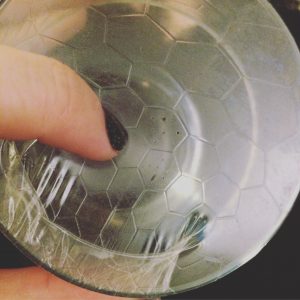I really don’t want to be writing this. Well no, that’s not true. I don’t want to have to write this, but sex education is lacking as it is and far too many people are being rather lackadaisical about the whole thing. Because I can’t in good conscience let condoms which can’t reliably condom be on the market without speaking up. Because I am Not OK with Lelo’s Hex.
 It all began on April Fools Day, at least for most of us. My colleagues and I awoke on the most distrustful day of the year to an email from from “lifestyle-brand” sex utensil manufacturer Lelo announcing Hex, a “revolutionary” new condom. I was, understandably, skeptical but reliable sources reported that no, despite the unfortunate (and somewhat foreshadowing) name it was legit. Lelo was trying something new. Questions abounded: What was going to be different? Will there finally be more non-latex options? Had Lelo teamed up with one of the Bill & Melinda Gates Foundation startups? But Lelo was pretty tight-lipped about the whole endeavour.
It all began on April Fools Day, at least for most of us. My colleagues and I awoke on the most distrustful day of the year to an email from from “lifestyle-brand” sex utensil manufacturer Lelo announcing Hex, a “revolutionary” new condom. I was, understandably, skeptical but reliable sources reported that no, despite the unfortunate (and somewhat foreshadowing) name it was legit. Lelo was trying something new. Questions abounded: What was going to be different? Will there finally be more non-latex options? Had Lelo teamed up with one of the Bill & Melinda Gates Foundation startups? But Lelo was pretty tight-lipped about the whole endeavour.
Until the product launch.
Lelo didn’t so much “launch” Hex, as made an IndieGoGo page to raise money for… well, I’m not even really sure. Hex was already in production. Launch gala attendees were treated to live demonstrations of the condoms features- including “revolutionary” patterning and a base emblazoned with the word “RESPECT” meaning “respect the man who wears it” according to what Gizmodo writer Bryan Menegus was told. This was also when we learned that Charlie Sheen had been selected as the spokesman for the new prophylactic. Now, I’m not even going to go into this bit because while it is a problem a) others have already written about this rather well and b) I am better able to forgive a poor spokesman choice than I am the design/safety issues of Hex.

As I looked through the press-kit Lelo sent me, I was faced with a distressing image. An animated GIF of a stretched-out Hex being repeatedly poked with a pin. Lelo was showcasing a feature of their new condom, which was still latex by the way, that you could poke a hole in it without breaking the it in any noticable way. Read that again. This is an advertised design feature. I am Not OK with this.
 Mysteriously, Lelo sent me a 3-pack of Hex. That same day fellow sex-ed writer Aerie arrived to spend the weekend with me. It was clear that we had to do an unboxing and livetweet/instagram the occasion. Hex was pretty much what I expected- inside each square foil pouch was a standard sized and shaped lubricated latex condom embossed with a hexagonal pattern “inspired by graphene”.
Mysteriously, Lelo sent me a 3-pack of Hex. That same day fellow sex-ed writer Aerie arrived to spend the weekend with me. It was clear that we had to do an unboxing and livetweet/instagram the occasion. Hex was pretty much what I expected- inside each square foil pouch was a standard sized and shaped lubricated latex condom embossed with a hexagonal pattern “inspired by graphene”.
Let’s pause for a moment here to remember what the purpose of a condom is. Scarleteen defines a condom as:
“A thin sheath or tube of latex or another material, worn over the penis during sex to prevent or reduce the risk of pregnancy and/or sexually transmitted infections.”
Most modern condoms are made from polymers (latex, polyisoprene, polyurethane, nitrile, etc.), however condoms have historically been made from the intestinal tract of sheep ((brings a whole new meaning to a sausage party now doesn’t it?)). Beside the squeamy factor of “sheepskin” condoms, as they are kinda incorrectly called, they are also ineffective for one of the two major roles of a condom. Guts have holes in them, tiny pores and the like, which allow them to do their thing while they’re still inside a living being. Great for the sheep, bad for STI protection. They work to reduce pregnancy because on a micro-biological scale, sperm a pretty big ((the head of the average human sperm cell is 3 µm by 5 µm. That’s 0.003mm x 0.005mm. For reference, the smallest the human eye can see unaided is roughly 0.1mm)), and the natural pores of the intestine are small enough to sieve them out while bacteria and viruses are much smaller and easily pass through. What does that have to do with Hex (which I’ll remind you is still boring old latex)?
 Well, I tried their pin-prick test and was horrified to find that the marketing GIF was not a dramatisation. I could indeed pierce Hex several times per region and the condom gave no fucks. “So what?” people retorted. Afterall, isn’t some protection better than none? Aren’t I making raging assumptions that a condom which remains intact despite perforation is worse than a condom which shatters upon puncture? I’m not kidding- these were the arguments that resulted in my Hex experimentations. And no, in this case I’m not so sure that some is better than none, or that any assumption I’m making about the percentages of transmission matter in the least. And here’s why:
Well, I tried their pin-prick test and was horrified to find that the marketing GIF was not a dramatisation. I could indeed pierce Hex several times per region and the condom gave no fucks. “So what?” people retorted. Afterall, isn’t some protection better than none? Aren’t I making raging assumptions that a condom which remains intact despite perforation is worse than a condom which shatters upon puncture? I’m not kidding- these were the arguments that resulted in my Hex experimentations. And no, in this case I’m not so sure that some is better than none, or that any assumption I’m making about the percentages of transmission matter in the least. And here’s why:
While it sucks to have a condom break, the way in which they break acts as, whether intentionally or not, a red flag system. The shattering of the condom means you know that your barrier has failed and that you now need to take steps to address the situation- emergency contraception, STI testing, post-exposure STI prophylaxis (where applicable and available), implementation of barrier methods with otherwise fluid-bonded partners, whatever an instance of exposure means to you. The manner in which Hex fails, however, means the sex act can be completed and there be no sign that there was a breech of security. While we no longer live in a world where contraction of HIV is a guaranteed death sentence, we do live in a world of super gonorrhoea, the Zika virus, and medically resistant syphilis. Pregnancy is still a high-risk medical condition. For a product with “RESPECT” emblazoned up it, Hex doesn’t seem to respect your right to know what’s up when you fuck. Remember that bit I said about microbe size? They make sure to tell you that the box Hex comes in tamper-evident, though. Thanks?
 Maybe this doesn’t bother people because everyone is just numbed to the non-sensical nature of the condom industry. The most widely known brand is named for a sneak-attack, after all. I mean- Trojan? A tale of a perceived peace offering that, once brought inside the city walls poured fourth with men to seize the city? That’s supposed to make me feel safe? And Hex. Really? Hex? I know they meant it as a reference to their silly textured surface (I’ll get to that in a minute) but all I can think of are curses. I’m still left agog at the number of people whose bios include the job title of “sex educator” who have fired back at me on Twitter or Instagram that they don’t understand why I’m upset, or they don’t get why this is a problem. Remember too that this isn’t just a side-effect of the design, this is a built-in feature. Lelo is marketing Hex by showing off that it doesn’t shatter when it develops a hole and apparently people are buying the hype.
Maybe this doesn’t bother people because everyone is just numbed to the non-sensical nature of the condom industry. The most widely known brand is named for a sneak-attack, after all. I mean- Trojan? A tale of a perceived peace offering that, once brought inside the city walls poured fourth with men to seize the city? That’s supposed to make me feel safe? And Hex. Really? Hex? I know they meant it as a reference to their silly textured surface (I’ll get to that in a minute) but all I can think of are curses. I’m still left agog at the number of people whose bios include the job title of “sex educator” who have fired back at me on Twitter or Instagram that they don’t understand why I’m upset, or they don’t get why this is a problem. Remember too that this isn’t just a side-effect of the design, this is a built-in feature. Lelo is marketing Hex by showing off that it doesn’t shatter when it develops a hole and apparently people are buying the hype.
I can’t help but feel like this is hugely irresponsible on Lelo’s part. People who buy these condoms, which retail at $10 for a 3pk, are seeing the name Lelo and recognising it as a leader in the intimacy industry. There is prestige and quality built into the Lelo name. There’s also a bit of tricky wording connected to Hex- “inspired by graphene ((Graphene is actually pretty cool stuff: https://en.wikipedia.org/wiki/Graphene)), the thinnest, strongest structure known to science”. With the Gates Foundation fueling condom research, talk of graphene condoms have been in the news for years. When I started learning more about Hex, even I thought that Lelo must have teamed up with one of the groups working on graphene barriers. But no, Hex is not graphene. Hex is a latex condom with a honeycomb pattern to it and a lot of misleading text on the packaging about graphene. There’s nothing “re-engineered” about them.
 I’m not so sure we need to re-engineer the condom, from a design aspect. Condom design isn’t the reason that people don’t use them anyway. What does need “re-engineering” is sex education, accessibility, and our cultural approach to condoms. Let’s put some of this condom research money into increasing the non-latex condom market and improving availability/accessibility (and yes, possibly more designs) of internal condoms. Let’s put some of that condom research money into actually doing research on condoms for anal sex, because telling folks to “consult [their] healthcare provider for advice” when using barriers for anything other than vaginal intercourse is absurd. And let’s put some of that condom research money, no- let’s put a lot of that condom research money, into improving sex education. That is what will be truly revolutionary and “re-engineer” how people use condoms.
I’m not so sure we need to re-engineer the condom, from a design aspect. Condom design isn’t the reason that people don’t use them anyway. What does need “re-engineering” is sex education, accessibility, and our cultural approach to condoms. Let’s put some of this condom research money into increasing the non-latex condom market and improving availability/accessibility (and yes, possibly more designs) of internal condoms. Let’s put some of that condom research money into actually doing research on condoms for anal sex, because telling folks to “consult [their] healthcare provider for advice” when using barriers for anything other than vaginal intercourse is absurd. And let’s put some of that condom research money, no- let’s put a lot of that condom research money, into improving sex education. That is what will be truly revolutionary and “re-engineer” how people use condoms.